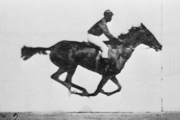


THE DIGITAL INTERMEDIATE - FILM
FOREWORD
Cinema as we traditionally perceive it began at the end of the nineteenth century, culminating from a number of quite separate technologies forged together. Projected pictures (like today’s slide projectors), known as the magic lantern were a pre cursor to the idea of film, however these early principals were held back by the lack of a bright enough light source.
Stills photography had also started in the mid nineteenth century but extremely long exposure times, often as long as an hour made moving objects impossible to capture within an image. The illusion of movement had been demonstrated in a variety of toys such as the Zoëtrope. In 1877, advances in photography allowed Eadweard Muybridge to combine these ideas for motion analysis – he combined 24 cameras to capture a couple of seconds of a horse’s movement, a primitive time lapse idea.

Animation of the captured images
Eventually George Eastman produced and patented a flexible photographic film. A transparent roll of 35mm film with an emulsion layer, which reacted to light when exposed producing an image. William Kennedy Dickson developed a camera that used this film and the pictures they captured were shown in what was known as a peep show viewer – or the kinetoscope. The film ran continuously and was lit by momentary flashes from a revolving shutter in front of a lamp.
Four year later the Lumière brothers demonstrated the cinématographe. A combined camera printer and projector, which used a claw mechanism for the first time so each individual frame was stationary during exposure or projection. Each film was 17 meters long, which, when hand cranked through a projector, ran approximately for 46 seconds. Persistence of vision did the rest and motion pictures were born.
Frame rates were variable, dependant on how fast or slow the operator cranked the handle until the introduction of sound in 1927. 24 frames per second then became an international standard. The first modern colour film, Kodachrome, was introduced by the Eastman Kodak Company in 1935, using three photosensitive emulsions – sensitive to red, green and blue.
Throughout the nineties the full impact of digital VFX became apparent – Steven Spielberg realised the terror of living, breathing dinosaurs in Jurassic Park. Then James Cameron conjured ‘the ship of dreams’ into the consciousness of billions with Titanic. It does seem possible ... if we dream it, we can begin to realise it. The noughties saw VFX truly come of age seamlessly becoming part of the narrative. The teenies seem to have thrust 3D to the forefront becoming a staple part of our cinematic experience. Hopefully the imagery will be pushed harder with full 4K and high frame rate technology becoming the standard.
Through this technological march, manufacturers and pioneers developed equipment to bring us this spectacle allowing film to be scanned into a digital format. This allowed us to manipulate it within a computer adding FX, print it back to film and seamlessly reinsert the ‘enhanced’ sequence back into the final edit. Reaching further than digital FX, the digital intermediate process was born as these technologies progressed and the ideology grew. Creative possibilities which previously were only seen in advertising and the television industry, such as creative colour timing, is now truly embraced by the cinematographer to enhance the look or style of their project. Pioneered by smaller budget feature film makers, the Digital Intermediate or DI has become yet another tool for the film maker’s repertoire.
Digital capture and digital presentation make this process even simpler, as the footage can be directly imported to the project. The scanning and final "film out" process' are slowly changing but the process is still a massive part used for restoration and the final optical printing for other markets, where digital projection is not yet the norm.
Within this website I will look at the ideas and workflow encapsulating the Digital Lab, moving away from the chemical alternative. Not just because it offers a more flexible approach but mainly because it is in tune with the approach in which most directors cut their teeth, entering the industry.
Film - Old & New
Within the Digital Intermediate realm, in reality you will probably only ever deal with 'new' 35mm, however there is always a chance of working with old stocks. Whether you are re-mastering a classic, or simply utilising stock footage, it is useful to know a little about older film. Ultimately you may find yourself restoring something as unique as the 'Battle Of The Somme' - 1916, or something a little newer like 'African Queen.' Personally I feel understanding these films will bring a little more respect and understanding for the pioneers of past and present film makers.
I would like to make it clear, you never really know exactly what you may be scanning or working with. I recall a restoration project I was involved in a number of years ago - the reel was supposedly a safety copy from the archives. However six of us stood watching helplessly as a Spirit burst in to flames behind closed glass doors. The halon dampers seemed to work momentarily only to reignite after they had gone off. Basically the safety copy was not particularly safe, the dissolves and transitions were edited in using nitrate stock! Which apparently, I discovered was common practice in times past, even after safety stock was introduced.
The point being is that you can never fully work out what you are dealing with and exposing film to a slow transport with an extremely hot 'xenon' lamp can just be tempting fate. I would recommend that anyone scanning old material to first give it close scrutiny and secondly to use scanning techniques that uses LEDs as the flashing device - such as the Arriscan.
Nitrate
Nitrate film base was the first transparent flexible plasticized base commercially available, thanks to celluloid developments by John Carbutt, Hannibal Goodwin, and Eastman Kodak in the 1880s. Eastman was the first to manufacture this for public sale, in 1889. Unfortunately, nitrate also had the drawback that it was extremely flammable and decomposed after several decades into a no less flammable gas, leaving the film sticky and goo-like. As this happened, the likelihood of auto-ignition increased even further. Projection booth fires were not uncommon in the early decades of cinema if a film managed to be exposed to too much heat while passing through the gate, and several incidents of this type resulted in audience deaths by flames, smoke, or the resulting stampede. While an accident of this sort was famously recreated in Cinema Paradiso, the risk was certainly not fictional, because the ignition of cellulose nitrate creates its own oxygen, nitrate fires can be very difficult to extinguish. Most nitrate films have been converted in recent decades to polyester copies, and original nitrate prints are generally stored separately to prevent a nitrate fire from destroying other non-nitrate films. Usually a theatre or post production facility today needs to pass rigorous safety standards and precautions before being certified to work with nitrate films. They are classified as "dangerous goods" and requires extreme caution while in storage and during transportation.
Acetate
Despite the dangers of the nitrate being known since its development, it was used in virtually all major motion pictures prior to 1952, when Kodak completed a four year conversion program to the sole manufacturing of acetate base film stocks. Kodak actually began working with acetate "safety film" as early as 1909, and started selling it in 1910 for 22 mm film. Acetate has always been used with 8 mm and 16 mm formats, as they were originally created for amateur home movie usage, and generally was used for most sub-35 mm formats to minimize risk to the general public. (Several formats, such as 17.5 mm, which were often re-slit from 35 mm were nitrate, however. One of Kodak's reasons for choosing 16 mm instead of 17.5 mm for a standard amateur format width was specifically to prevent nitrate re-slits from being used in home movies.)
Acetate is the only base which has been used with colour negatives. All motion picture camera negatives are now shot on acetate film because it is safer than nitrate but not as strong as polyester bases, which may damage the camera rather than the film should a jam occur. Acetate can also be spliced with film cement, while polyester can only be spliced with tape or an ultrasonic splicer, so polyester would be hard to edit. Acetate film does not burn under intense heat, but rather melts, causing a bubbling burn-out effect. Acetate films are also subject to degradation over time. With exposure to heat, moisture or acids the acetyl groups which are attached to long chains of cellulose which form the film base are broken from their molecular bonds and free acetic acid is released with a characteristic smell of vinegar. This is known as vinegar syndrome. As the degradation progresses the film base becomes brittle and shrinks.
Polyester
Polyester is the most recent film base to have been developed, and was first used for specialized photography applications in 1955, but it was only in the 1990s that it became overwhelmingly popular for motion picture prints. It is highly preferable for post-production, exhibition, and archival purposes because of its flexibility, strength, and stability. Its strength is sometimes also seen as a disadvantage, however, in that polyester-base films are so resistant to breakage that they are often more likely to break the film equipment should a jam or extra tension occur. Movie cameras therefore do not use this base for shooting the original camera negative, as it is vastly preferable and less costly in time and money for the film to break instead.
Identifying a Film Base
There are several factors which can aid in identification of the film base of a roll of film. Many are not 100% conclusive, and it is best to use a selection of these to positively verify a film base.
Printed along the edge of the film:

